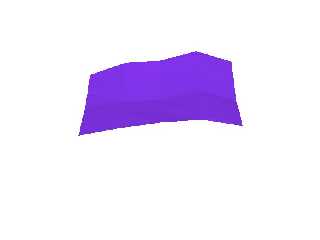|
 |
High!
(see also code files on p.b.s-f!)
After some delay, I finally found out how mesh2s and smooth_triangles
work - starting with a hand-coded 5 by 5 mesh, whose smoothed version
looks convincing at least to me (both non-smoothed and smoothed version
attached here).
But then I also tried this on the curved mesh2 (following Earth
curvature) from the 1200 by 1200 SRTM data of some mountainous Afghan
wilderness west of Kabul... and got a VERY strange appearance of the
mesh (also attached).
Not only that most of the topography is lost to a strange regular normal
pattern, but also from about row 1100, normals are no longer averaged
any more (#warning output "division by zero", vector "norm" keeps its
initialization value of <0, 0, 0>), so that the foreground remains
unsmoothed!
What went wrong?
Am I, at all, right to assume that the average of vectors
<x1, y1, z1>, <x2, y2, z2>,...,<xn, yn, zn> simply is
<(x1+x2+...+xn)/n, (y1+y2+...+yn)/n, (z1+z2+...+zn)/n> - or am I barking
up a totally wrong tree?
Another question, going much further into possible methods of 3D terrain
modeling: as meshes (as well as heightfields) aren't really the golden
road to photorealistic terrains based on real elevation data, I thought
about computing an approximating function for each data column and row
respectively and then "cross-approximating" somehow these two arrays of
functions (in my case, each containing 1200 functions) in to one
incredible complex function describing the whole data matrix as an
isosurface.
Has such an algorithm ever been programmed, perhaps even in the POV
world? I don't think of the hf_mesh_isosurface functions by Chistoph
Hormann et al. (which just generate one function for each data point),
but a solution which yields really smooth isosurfaces out of data
matrizes...
See you in Khyberspace!
Yadgar
Now playing: Le Parc (Tangerine Dream)
Post a reply to this message
Attachments:
Download 'mesh2test.jpg' (9 KB)
Download 'mesh2test_smoothed.jpg' (8 KB)
Download 'sarehelmand_smooth.jpg' (49 KB)
Preview of image 'mesh2test.jpg'

Preview of image 'mesh2test_smoothed.jpg'

Preview of image 'sarehelmand_smooth.jpg'

|
 |




![]()